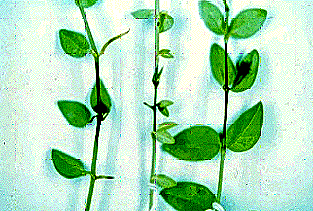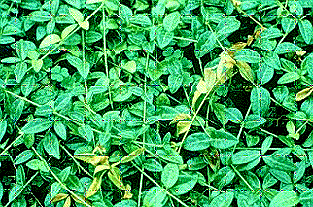|
Stem blight is a serious disease of Vinca minor, commonly known
as periwinkle or ground myrtle. The disease is widespread and potentially
destructive wherever this popular ground cover is grown in the United
States and Europe. Vigorous, established plants produce abundant new shoot
growth, but hidden below this new foliage can oftentimes be found severely
infected and damaged old runners. Stem blight may be so severe that attempts
to maintain vinca plantings fail, and the plants have to be removed and
replaced with other ground covers. Damage is most prevalent in cool wet
weather in spring and, to a lesser extent, in autumn when soil moisture
is high. Newly planted beds, where plantings are thin and not well established,
are particularly susceptible.
Incidence of the disease tapers off during the hot dry weather of summer,
however, in prolonged periods of cool wet weather, new infections can
occur from June through August. Stem blight can also be a severe problem
in nurseries where plants are grown under mist propagation.
Stem blight is caused by Phoma exigua var. exigua, a fungus
that grows and persists indefinitely in moist soil and plant debris and
attacks big-leaf or variegated vinca (Vinca major). The fungus
has been repeatedly isolated from plants shipped into Illinois from propagating
nurseries in other states. It is not unusual for vinca plants to appear
healthy when received from a grower, only to become diseased when planted
in sterilized soil. The causal fungus is probably in or on the soil in
most diseased plantings.
Back to Top
|

Figure
1. Stem blight on Vinca minor runners
|

Figure
2. Phoma exigua causing stem blight on Vinca Minor.
|
Symptoms
Soon after the new green shoots appear in late April or early May, rapidly
expanding, dark brown to black girdling lesions appear on the stems of
overwintered runners at the ground line, causing them to die back to the
base. Some lesions may extend the entire length of the stem in just a
few days. Lesions soon appear at the stem base on the new shoots and at
nodes along the runner stems (Figure 1) where the stems contact the soil
or nearby infected plant tissue. The stems soon wilt, turn dark brown
to black, and die. After several weeks, entire clumps of plants may wither
and die. The fungus frequently spreads from stem lesions into the leaf
petiole and base of the leaf (Figure 2).
Dark spots may occasionally form in the leaves (Figure 3) and cause the
leaves to turn brown, wither, and generally drop prematurely. These leaf
spots are not ordinarily associated with stem infections.
Back to Top
Disease Cycle
The stem blight fungus grows saprophytically throughout moist soil (soil
with a moisture content greater than 50 percent field capacity) and commonly
colonizes dead and dying plant material. The fungus is believed to overseason
as dormant mycelium and as speck-sized, brown to black fruiting bodies
(pycnidia) on the dead stems and leaves.
The dormant mycelium resumes growth in the spring about the time new
leaves and shoots appear on vinca plants. Microscopic spores (conidia),
produced in tremendous numbers within the pycnidia, probably provide an
important source of early season infections, disseminated primarily by
splashing and flowing water. Infections usually occur when the temperature
is between 50 and 65 F (10 to 18 C). Wounding is not required for infection
to take place. Stem lesions are evident 10 to 15 days after infection
occurs. The cycle of infection, disease development, symptom expression,
and reinfection may be repeated as long as cool, damp conditions prevail
and the soil moisture remains high.
Back to Top
Control
1. For new beds, select and plant only vigorous, disease-free
stock purchased from a reputable nursery.
2. After transplanting, apply only enough water to maintain vigor. Avoid
frequent irrigations if the soil is sufficiently moist for good growth.
Mulch newly planted vinca beds with 6-mil black plastic, perforated every
four to six inches, and covered with pea gravel or rough ground corn cobs.
This type of mulch promotes rapid establishment of plant root systems
and reduces competition by broadleaf weeds and grasses. The vinca plants
also survive winter in a more vigorous condition under this type of mulch.
3. Once vinca beds are well established and healthy, the annual spring
soil drench may be eliminated entirely. Annual drenches in April or early
May may be resumed if stem blight again becomes a serious problem.
Refer to the Illinois Homeowner's Guide to Pest Management for chemical
control. This publication is revised annually and is available from the
Information Technology and Communication Services at the University of
Illinois.
Back to Top
|



